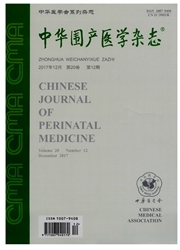

 中文摘要:
中文摘要:
目的探讨胎儿先天性心脏痫基因型与临床表型之间的关联性,旨在为先天性心脏病遗传学咨询发病机制研究提供信息。方法选取2012年9月至2015年6月间首都医科大学北京安贞医院胎儿心脏病母胎医学会诊中心胎儿心脏畸形数据库心肌等组织标本62例,按区段月不胎学分类法进行分型,并送深圳华大基因研究院利用全基因组低覆盖度测序检测染色体缺失/重复,目标区域捕获测序检测先天性心脏病相关基因的单核苷酸变异及小的捅入缺失片段。结果(1)本研究中胎儿先天性心脏病以圆锥动脉干畸形(conotruncal defects,CTD)最常见(69.4%,43/62)。(2)共30例胎儿检出〉100kb的拷贝数变异(copy number variations,CNVs)(48.4%,30/62),其中11例检出〉1Mb的CNVs,11例中7例为致病意义明确,7例中有6例心脏临床表刊累及CTD。(3)5例胎儿检出已知及疑似致病基因,其中4例胎儿存在心室流出道梗阻。结论本研究中胎儿的心脏临床表型以CTD常见,检出致病意义明确的胎儿心脏表型亦以CTD常见;检出疑似致病突变基因的胎儿,其临床表型以心事流出道梗阻多见。
 英文摘要:
英文摘要:
Objective To explore the relationship between genetic phenotypes and clinical characteristics of fetal congenital heart disease(CHD) using low-coverage whole genome sequencing and target sequencing. Methods Tissue specimens of 62 fetuses with CHD diagnosed by fetal echocardiography and confirmed by post-mortem autopsy from September 2012 to June 2015 were selected from the fetal cardiac malformation database of the Consultation Center of Maternal Fetal Medicine in Fetal Heart Diseases, Beijing Anzhen Hospital, and classified according to the sectional embryology classification method. Low coverage whole-genome sequencing and target sequencing were performed to detect chromosomal deletions or duplications and single nucleotide variation and small insertion/deletion fragment of CHD related genes. Results (1) Conotruncal defects (CTD) were the most common (69.4%, 43/62) seen CHD in this group. (2) Copy number variations (CNVs 〉100 kb) were detected in 30 fetuses and CNVs ( 〉1 Mb ) were detected in 11 fetuses out of the 30 fetuses (including seven fetuses with determined pathogenic CNVs, six of whom were involved with CTD). (3) Known or suspected pathogenic genes were detected in five fetuses, four of them had ventricular outflow tract obstruction. Conclusions CTD is most common in fetal CHD; most of the fetuses with pathogenic CNVs are complicated with CTD; and most of the fetuses with likely pathogenic genetic mutation are involved with ventricular outflow tract obstruction.
 同期刊论文项目
同期刊论文项目
 同项目期刊论文
同项目期刊论文
 Application of spatio-temporal image correlation technology in the diagnosis of fetal cardiac abnorm
Application of spatio-temporal image correlation technology in the diagnosis of fetal cardiac abnorm Application of two-dimensional echocardiography combined with enhanced flow in diagnosing fetal hear
Application of two-dimensional echocardiography combined with enhanced flow in diagnosing fetal hear Intracardiac Leiomyomatosis: Clinical Findings and Detailed Echocardiographic Features-A Chinese Ins
Intracardiac Leiomyomatosis: Clinical Findings and Detailed Echocardiographic Features-A Chinese Ins Application of Two-dimentional Echocardiography Combined with Enhanced Flow In Diagosing Fetal Heart
Application of Two-dimentional Echocardiography Combined with Enhanced Flow In Diagosing Fetal Heart Diagnostic value of an ROC vurve of the size of the antepartum foramen ovale in the prediction of pu
Diagnostic value of an ROC vurve of the size of the antepartum foramen ovale in the prediction of pu 期刊信息
期刊信息
